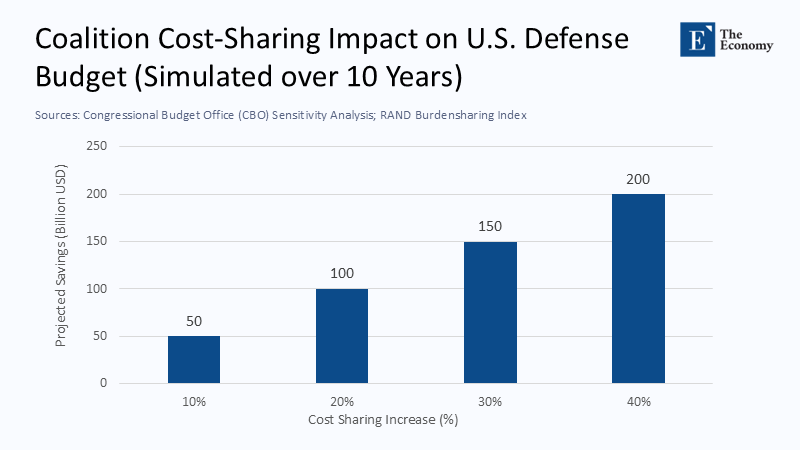Input
Changed
This article was independently developed by The Economy editorial team and draws on original analysis published by East Asia Forum. The content has been substantially rewritten, expanded, and reframed for broader context and relevance. All views expressed are solely those of the author and do not represent the official position of East Asia Forum or its contributors.

The United States’ near‑trillion‑dollar defense budget guarantees command of the battlespace, but in a century where legitimacy moves faster than logistics, coalition consent is the only currency that translates firepower into durable influence.
Saigon, Kabul, and the Geometry of Overreach
Images of Huey helicopters lifting from Saigon’s embassy in 1975 were supposed to become archival curiosities, yet half a century later, their contours reappeared at Hamid Karzai International Airport. Both evacuations revealed the same theorem: concentrated force can seize territory, but only granular partnership secures political altitude. The lesson was unpacked last week by East Asia Forum, which traced Washington’s tendency to “swing a hammer where scalpels are needed,” warning that sheer power, when unbalanced by local agency, triggers backlash strong enough to reverse strategic intent.
That point extends beyond Afghanistan. The Islamic State’s rapid rebound in northern Iraq after 2011 and the halting stabilization of Libya after 2011 prove that public authority follows social networks, not troop density. Force can evict a regime, but if the successor’s legitimacy is outsourced to foreign armor, domestic actors eventually turn the guns inward—a political version of Newton’s third law. However, the potential for strategic empathy and understanding of local dynamics and needs offers a hopeful path forward in international relations.
The Diminishing Returns of Defense Dollars
SIPRI’s fresh tally puts U.S. military outlays at $997 billion in 2024, a sum larger than the following nine countries combined and equaling two-thirds of all NATO spending. Yet, the Afghanistan venture alone absorbed an estimated $2.3 trillion over two decades, exclusive of veterans’ care. Divide that figure by Kabul’s final‑hour implosion, and the marginal utility of each additional dollar trends toward zero.
The wider system is catching on. Worldwide military expenditure jumped to a record $2.72 trillion in 2024, a 9.4 percent surge that outpaced global GDP growth and marked the sharpest annual rise since the Cold War. In other words, competitors have learned to answer steel with more steel, converting U.S. spending into an arms‑race tax on its treasury.

Networked Multipolarity: A New Balance Sheet
Raw numbers still matter—carrier strike groups are not academic constructs—but their translation into leverage now passes through dense subnetworks of middle powers. RAND’s Burdensharing Index shows that allies in Europe and Asia already shoulder more than half the total cost of sustaining the post‑1945 security architecture, contributing disproportionate shares of ground forces and personnel. At the same time, Washington provides air, naval, and ISR assets.
This reality undermines narratives that depict the United States as an isolated sheriff. America’s strength has migrated from kinetic superiority to convening power: it is not the biggest spender alone, but the anchor of the world’s most valuable interoperability club. If those members disengage, the Pentagon’s budget becomes an over‑capitalized solo project in a world of joint‑venture geopolitics.
Home‑Front Veto Power
Domestic opinion completes the pincer. Gallup’s March 2025 survey registers that two‑thirds of Americans still want their country to play a “leading or major role” abroad, but partisan patience for open‑ended deployments has eroded. Overseas, the U.S. global approval rating slipped to 45 percent in the same poll cycle. War‑weariness is not isolationism but a demand for smarter arithmetic—fewer unilateral bills, more collective dividends.
When Partnerships Work: From Kyiv to Manila
Ukraine offers a laboratory of coalition leverage. The U.S. has supplied roughly half of Kyiv’s military aid, yet Europe now exceeds Washington in macro‑financial assistance and has eclipsed the United States in pledged artillery shells for 2025. Partner buy‑in converted a regional war into a strategic liability for Moscow without placing a single American brigade on the front line. Meanwhile, once hesitant to antagonize Beijing, the Philippines granted expanded base access to U.S. forces in 2024 only after Washington agreed to joint patrols that included Filipino commanders in the lead, symbolically flipping the optic from protectorate to partnership.
Contrast those cases with Libya, where NATO air power toppled Gaddafi but failed to birth a coherent political compact, or with Syria, where mismatched objectives among coalition members granted the initiative to Moscow and Tehran. The pattern is empirical: coalitions succeed when local stakeholders co‑author the mission statement and stumble when they merely countersign it.
Export Controls and the AUKUS Stress Test
Those who dismiss diplomatic fine print as detail‑clerking should study AUKUS. In April, U.S. officials confirmed that even the alliance’s new export‑control exemptions stop short of the most sensitive submarine technologies, forcing Australian firms into time‑consuming ITAR license queues that could delay Virginia‑class deliveries beyond 2035. The paradox is brutal: Washington proposes an Indo‑Pacific counter‑weight to China, then constrains its partners’ access to the industrial ecosystem required to build it. Unless regulatory regimes synchronize with strategic rhetoric, the submarine pact may produce more talking points than hulls in the water.
Quantifying the Burden‑Sharing Opportunity
Budget offices have begun to map the payoff of coalition primacy. A Congressional Budget Office sensitivity analysis—initially designed for deficit modeling but re‑run here for defense scenarios—shows that every ten‑percentage‑point shift in operational costs from unilateral to shared financing saves the U.S. roughly $50 billion over a decade, even before secondary benefits such as local basing contributions are counted. The potential for significant cost savings through shared financing is a compelling argument for coalition-based defense strategies.
The politics align with the math. Poland’s pledge to fund $3.6 billion in infrastructure to host a U.S. armored brigade is not charity; it is a tangible example of allies internalizing the marginal costs of deterrence. Every dollar Warsaw spends on barracks and rail sidings is a dollar the Pentagon can redirect to contested domains such as cyber or space.

Strategic Recommendations: Embedding Partnership in the Operating System
Washington’s problem is not a lack of allies but a doctrine treating them as bolt‑on enablers rather than co‑authors. Rectifying that mindset requires upgrades across four layers of statecraft.
First, design mandates: joint planning cells must give key partners reciprocal veto power over mission expansion. A shared red line deters both free‑riding and reckless escalation.
Second, financial engineering: convert Foreign Military Financing into a tiered, interest‑free loan facility tied to local procurement thresholds. Israel’s graduation from aid client to export powerhouse demonstrates how concessional credit can bootstrap an indigenous defense sector while deepening strategic alignment.
Third, regulatory harmonization: the ITAR carve‑outs piloted for AUKUS Pillar II should become the default template for the Quad and NATO, replacing case‑by‑case waivers with license‑free zones aligned to mutually agreed threat inventories. The urgency of this issue cannot be overstated, as it directly impacts the effectiveness of international defense strategies.
Fourth, digital public goods: export‑controlled hardware matters, but open‑source 5G and satellite‑imaging platforms amplify influence at the speed of software, domains where China’s Belt and Road financing has already made inroads.
From Muscle Memory to Strategic Empathy
The United States still holds the world’s largest economy, its most‑capable navy, and a lattice of alliances that spans every time zone. It lacks the reflex to treat those alliances as strategy engines rather than endorsements delivered after the fact. Vietnam and Afghanistan are only the most photogenic autopsies of that reflex; the statistic that matters is the 37 percent share of global military spending for which Washington receives a shrinking slice of international legitimacy.
Strategic empathy—understanding how partners perceive their neighborhoods—does not require moral softness. Instead, it is the operating logic of a world where networks, not monopolies, allocate influence. The next administration—whatever its partisan hue—will confront crises that cannot be solved by air power alone: grey‑zone incursions in the South China Sea, quantum‑enabled cyber sabotage, or climate‑induced displacement across the Sahel. None lend themselves to decisive unilateral solutions; all reward pre‑wired coalitions capable of fusing intelligence, regulating technology flows, and pooling fiscal risk.
If Washington internalizes that calculus, its trillion‑dollar defense budget will be a magnet, attracting allied capacity that multiplies its effect. Ignore the calculus, and the ghost of Saigon will board the last helicopter from yet another capital whose name the American public learns only on the eve of departure. Power will remain, but untethered to partnership, it will be money transformed into momentary spectacle—bright, expensive, and strategically hollow.
The original article was authored by James Borton, a non-resident senior fellow at the Foreign Policy Institute of the Johns Hopkins School of Advanced International Studies (SAIS). The English version, titled "JUS foreign policy’s familiar follies show lessons not easily learnt," was published by East Asia Forum.





















